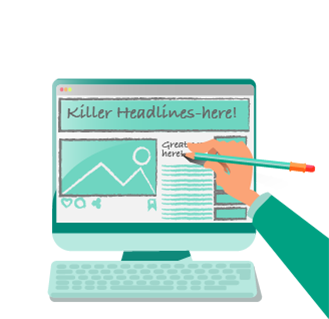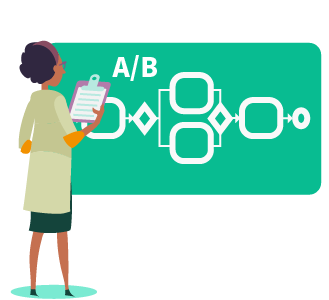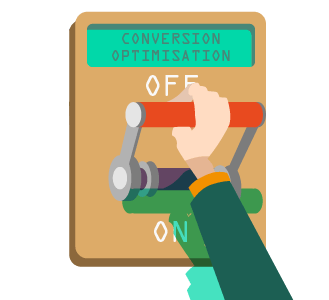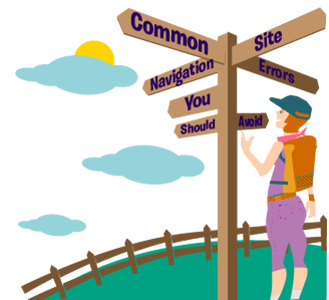Let’s begin by answering a straightforward question: What exactly is SEO?
Search engine optimisation (SEO) is all about using tools and techniques to increase the quantity and quality of web traffic to a website using non-paid advertising.
With over 6.5 billion web queries daily across millions of websites, most businesses are busy vying attention from prospects.
To rank on top of the search engine results page for terms related to your products and serves — and the problems they solve — you need to master search engine optimisation tactics.
A landing page is different from your business website.
Unlike a website’s homepage—which is generally the online ‘face’ of your company —landing pages help you build customer loyalty and increase profits by focusing on a specific short-term goal.
You can give users clear, direct calls to action using landing pages that serve unique campaigns, audiences, events, or even promotions.
Landing pages help you build customer loyalty and increase sales by pinpointing on a highly specific short-term goal.
Here are some tips to help you increase the conversion rates of your landing pages.
Set your landing page goals
Before you start building your landing page, you’ll need to know what’s the purpose of your landing page.
Are you looking to increase the number of your email newsletter sign ups? If that’s the case, creating a sign up help you grow your list.
Or perhaps you want to sell more of your product or service. Building a product page helps to advertise your business and sell items from your online store.
Whichever goals you choose, it is critical that you only choose only one goal for every landing page.
Having multiple goals confuse visitors, lowering your chances of conversion.
Say, for instance, you’ve established your goal of capturing fresh leads by getting visitors to provide their contact information in exchange for a new ebook.
At this point in the lead journey, visitors don’t need to hear about the history of the company, your upcoming webinar, or even the product or service you offer.
They only need to know why they should download the ebook. The landing page copy should clearly describe the “what,” “how,” and “why.”
When you can do this successfully, you reduce the conversion friction for your visitor.
Think of your audience
The best way to Increase the relevance of your landing pages—and increase your conversions— is by putting yourself in the shoes of your audience.
Ask yourself: What is the message you’re trying to tell?
The key takeaway is that every customer is different. So instead of using a generic landing page that gives the same experience for everyone, try building a few landing pages with different designs or copy, with each targeting a different segment of your business.
For example, if you operate a shoe store, you can create a series of landing pages using content that targets a different type of users.
One landing page might be targeting blue collared workers looking to buy safety footwear, which another one could be targeting at athletes looking for running shoes.
Or, you might create a landing page to share on Facebook, for driving new email signups, and another that you link to your VIP customers that showcases exclusive VIP-only products.
Experiment with different types of landing pages, each targeting a different segment of your audience.
Use a killer headline
A strong headline is critical to the success of a landing page.
It needs to:
- Grab the reader’s attention.
- Tell the user what the product or service is all about.
- Be twenty words or less, and preferably limit it to ten.
The key to a short and concise headline is to have it complement your hero image, that explains the product or service. This way, you won’t need to go into long headlines.
Write good copy
Similar to email and ad campaigns, you amplify the effectiveness of your landing pages when you place thoughtful copy that’s concise, relevant and riveting to your audience.
Headline: Craft a headline that arrests the visitors’ attention the moment they reach the page.
Body: Your message should be clear, informative, and direct. Afford fancy or flowery language.
If you’re promoting a sale, you can add a sense of urgency to your copy.
Or, if you’re collecting email addresses, be upfront about why you’re asking for their information and how are you going to use their information.
Call To Action (CTA):Keep your CTA clear and concise. Consider which stage of the buying process your customers are in, and then use the right angle for your CTA accordingly.
Footer: Include your contact details and your privacy policy, so your audience can easily reach you, and feel safe about giving away their details.
Include methods of contact
To tell visitors that your business is legit, you can do it through your landing page.
The most persuasive landing pages usually include one or more methods of contact, such as a phone number, an office address, an email address, and a contact form.
Some even have chat popups where a customer service rep asks the visitor f they can be of help. They may not be manned by a real person, but it helps to make the visitor feel welcomed and offers legitimacy to your business.
Little details such as this help to reinforce visitors’ trust towards your company and to remove any friction in the conversion funnel.
These are some of the things to keep in mind as you add contact information to your landing page:
You should provide visitors some assurance that you are a real company. Usually, this means sharing your physical address, business registration number, and phone number.
Live chats that show up in a popup can be helpful, but not necessary. If you insist on using one, find out what are your best options and make sure they do not make overwhelm visitors with too much activity.
It’s all up to you to decide how you want your visitors to get in touch. The smoother the contacting process is for your visitors, the more likely they’ll be to take action on your landing page.
Make use of beautiful graphics and images
Since the image is one of the first things visitors see when they hit upon your landing page, it’s crucial that it has a strategy behind it that results in leading customers towards taking action.
If you operate an online store, use pictures and images to show off your latest products.
Or you can make use of an eye-catching background image to grab the attention of your customers.
Graphics can help guide the user’s eyes around the page as well. Use this to your advantage and guide visitors towards your CTA.
When you choose and place your images, you should remember that:
The photos should be large.
The pictures should be relevant to your product or service. If you are selling a physical product, your landing page should feature the picture of your product prominently
If you are selling a service, focus on using the image to grab attention and demonstrate relevance.
The pictures need to be high-quality. This helps to build trust for the visitors.
And if you need to find the perfect image for your landing page, check out free stock photos such as Unsplash and Pexels.
One more tip – to avoid ending up using the same stock image as everyone else, you should do yourself a favour and run your pick through TinyEye, to see where else is using the same image.
Give an Explanation
Your landing page has to make what you’re offering perfectly clear for it to perform well.
After all, when visitors don’t understand what your product or service is about, you’ve lost them. So an upfront explanation is crucial.
If your landing page is a straightforward product or service, it’s possible for you to get away with just your headline and subheadline as the only copy on the page.
But no matter what’s your approach to explaining things, these are the things you should keep in mind:
You can choose to combine your explanation into your headline or keep them separate.
An explanation should be focused on the audience’s perks.
Your explanation doesn’t necessarily need to be separate from your headline and subheadline.
Each individual elements on your landing page might not do a good job explaining your product or service. But when you put them all together (headline, copy, picture, etc.), your page should explain its true purpose clearly and do what it needs to do.
That’s why for most landing pages, the old adage of keeping it simple goes a long way.
You might be tempted to make your page “fun” and “distinctive” — and that’s all great. But your utmost priority should always be on message clarity.
Convey Value or Perks
In a nutshell, your landing page has to answer the user’s question, “What’s in it for me?”
Similar to your explanation, your value proposition can be combined together with other elements on your page.
Here’s what you should consider when writing your value proposition:
Provide a list of perks using a bullet list. Bullets convey value directly to readers and make it easier for them to understand.
Perks should always be focused on the user. It’s easy to deviate and start talking about “features” of your product instead of the “benefits.” You should always think about how he or she will benefit from using your product.
A value proposition is not about telling your audience how amazing your company or your product is.
But your goal isn’t to brag about your company, as that doesn’t compel the reader to convert.
Instead, your landing page should always be user-centric, and how awesome with your product or service will make them.
Building trust and social proof with reviews
Consumers nowadays are much savvier. They tend to do their own research before making any decision to purchase.
Part of their research involves reading product reviews and testimonials. Online reviews can directly impact a business—shoppers care what other shoppers think.
In fact, based on research by BrightLocal, as much as 85% of consumers trust online reviews and respect them as much as personal recommendations.
Customer reviews are a mighty force that can help your landing page achieve success.
They offer value, increase personality, showcase existing customers (so your audience knows, for the most part, that they’re not the first people who have gotten involved with your business), and speak to the most human part of your business.
You should always be collecting positive feedback you’ve received from happy customers.
Find ways to include positive testimonials onto your landing page. Not only can their reviews help you give your advertising a boost, but they might also be the final nudge to move a prospect to a paying customer.
Take advantage of discount or promo codes
Coupons and promo codes make excellent and effective baits for driving massive sales for your business.
Based on a recent survey, 57% of consumers say that customers gravitate toward businesses that offer special deals for returning customers.
So as you build your landing pages for your business, consider including exclusive discount coupon codes or other unique offers a nice incentive for your visitors.
Each landing page can be independent of your site, store, or other marketing—so it’s easy to advertise an incentive to a small segment of your audience without upsetting any of your other marketing segments or strategies.
Promote your page
Once you’ve finished designing and publishing your landing page, it’s time to start promoting your live page to your audience.
You can share your landing page URL on your favourite social media of choice, or you can pay to drive traffic towards your landing page. A good option here would be to pay for Facebook Ads.
If your objective is to sell or launch a new product, you might want to consider an email campaign to build hype and have your subscribers go to your landing page.
If your marketing budget allows for physical promotion, you can even opt to set up a booth at events and trade shows to attract visitors and promote your site.
Host a contest online (or offline) and make contestants visit your site as part of the contest entry requirement.
Be strategic, be creative, and always use your other marketing channels to your advantage.
Also, don’t overlook the importance of small tactics. Sometimes even a simple link in your email or forum signature can do wonders to promote your landing page
Have a plan for the onboarding process
Whether you’re trying to grow your list or sell more stuff with landing pages, it’s essential to have a well-thought-out plan for everyone that clicks your CTA.
Most marketers rest on their laurels when they have gotten the desired conversion, but leave the audience high and dry.
To stop this from happening to you, make use of email autoresponder tools to help you keep in touch with your new subscribers and returning customers.
Always include highly personalised, relevant content to make every individual recipient feel like a VIP.
Keep the conversation going by introducing the folks behind your business—with an automated welcome series that sends out to whoever signs up through your landing pages.
Allow newcomers to catch up, tell them the background story of your business, or even give them a freebie (like an ebook, discount code) to welcome them.
You can also design and send personalised order confirmations, invoices, and other customer notification emails.
Or even automatically follow up with buyers to thank them for their purchase, provide useful product information, or ask for a review on their experience.
By having a well-laid out engagement plan, you can ensure your list stays engaged to your brand, and they will come back again.







